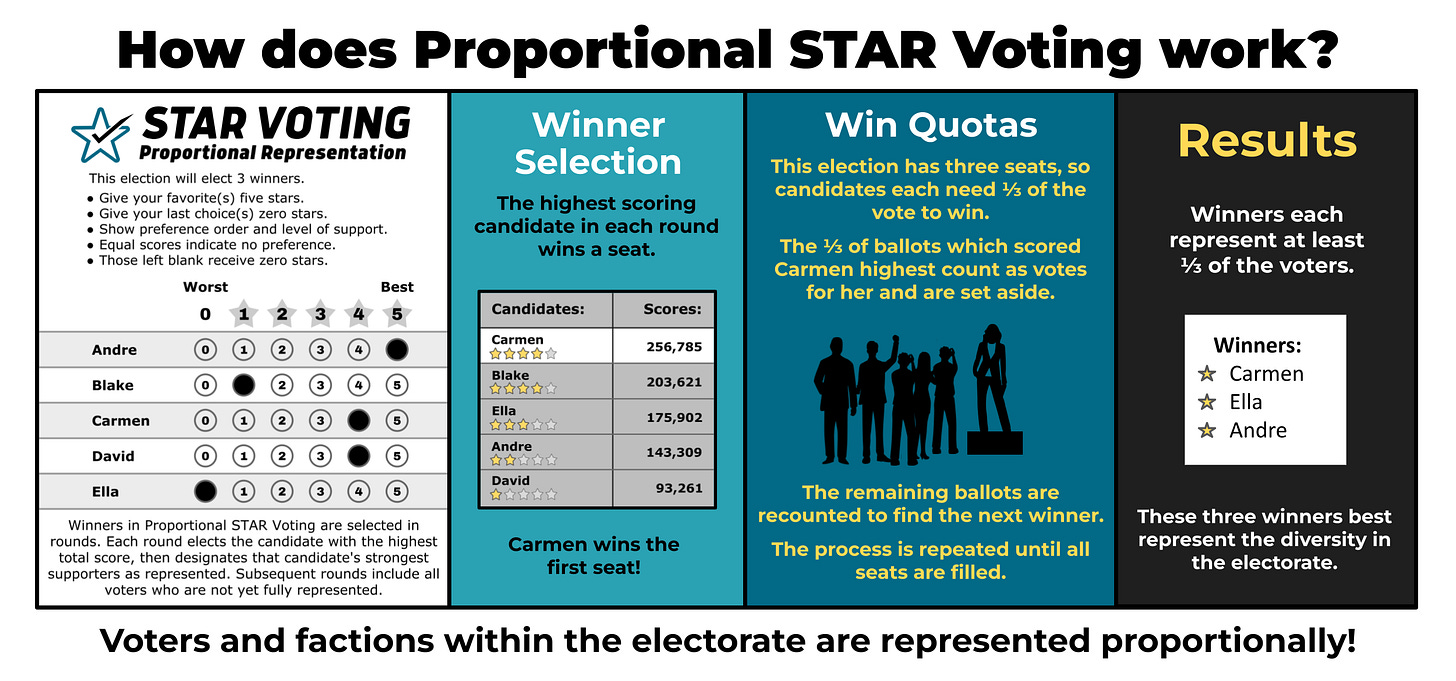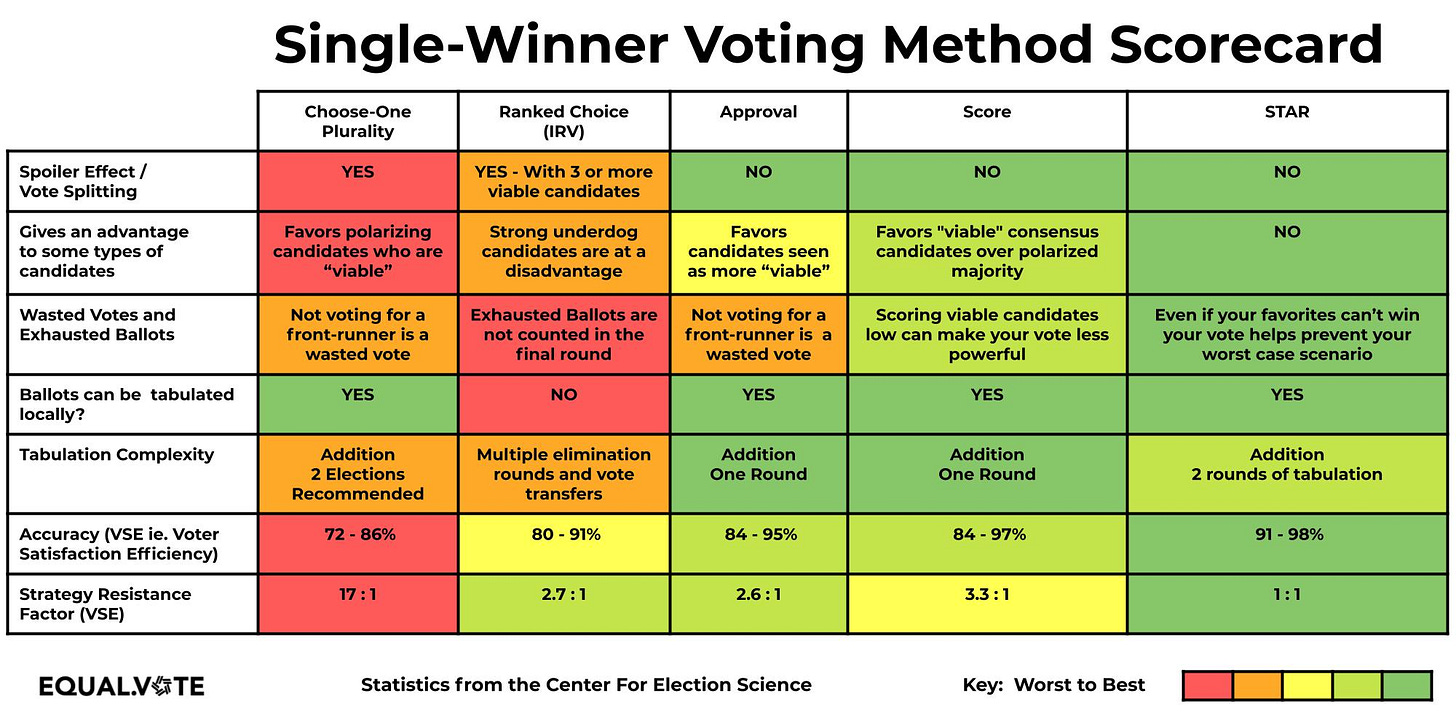Did you know that only 55.7% of eligible Americans voted in the 2016 presidential election, one of the lowest among developed nations? This low turnout reflects deep flaws in America's First Past the Post (FPTP) voting system, which often leaves voters feeling disenfranchised and dissatisfied.
Score Then Automatic Runoff (STAR) voting offers a superior alternative to current voting methods, addressing the critical flaws of FPTP and paving the way for a more democratic and representative election process.
Problems with the Existing First Past the Post Voting System
FPTP (also known as Choose One voting) is a simple plurality voting system where the candidate with the most votes wins, regardless of whether they achieve a majority. Historically, this system has been prevalent in the U.S. due to its simplicity and ease of implementation.
Issues with FPTP
Spoiler Effect: The spoiler effect occurs when a third-party candidate siphons votes from a major candidate, often leading to the election of the least preferred candidate. A notable example is the 2000 presidential election, where Ralph Nader's candidacy is widely believed to have contributed to Al Gore's loss to George W. Bush.
Wasted Votes: Wasted votes are those cast for losing candidates or surplus votes cast for winning candidates beyond what they needed to win. In the 2016 election, an estimated 60% of votes were wasted, either on candidates who lost or votes in excess for the winner, demonstrating the inefficiency of FPTP.
Limited Voter Expression: FPTP restricts voters to a single choice, often leading to dissatisfaction and underrepresentation. Voters cannot express their preferences for multiple candidates, resulting in a significant portion feeling their voices are unheard.
Polarization and Strategic Voting: FPTP encourages negative campaigning and extreme positions, as candidates focus on securing their base rather than appealing to a broader electorate. Strategic voting becomes prevalent, where voters choose the "lesser of two evils" rather than their preferred candidate, further deepening political polarization.
What is STAR Voting?
STAR (Score Then Automatic Runoff) voting allows voters to score candidates on a scale (typically 0-5). The two highest-scoring candidates then enter an automatic runoff, where the candidate who scored higher by more voters wins.
In single-winner elections, voters score each candidate. The two candidates with the highest total scores proceed to an automatic runoff. For example, if Candidate A and Candidate B have the highest scores, all ballots are reviewed to see which of these two each voter scored higher, determining the winner. In proportional representation, STAR voting can be adapted to allow voters to score multiple candidates in multi-member districts. This method ensures a more balanced and representative outcome, as it considers the intensity of voter preferences across a broader spectrum.
Why STAR Voting is Better than Approval Voting and Ranked Choice Voting (RCV)
Prevention of Spoiler Effects
Unlike Approval Voting and RCV, STAR voting effectively neutralizes the spoiler effect by considering voter preferences more comprehensively. In hypothetical scenarios, STAR voting consistently ensures that the most broadly supported candidate wins.
Elimination of Wasted Votes
STAR voting significantly reduces wasted votes by allowing voters to express their preferences for multiple candidates, ensuring that every vote contributes meaningfully to the outcome. This leads to higher voter engagement and turnout, as voters feel their choices have more impact.
Expressive and Nuanced Voting
STAR voting allows for more nuanced voter preferences compared to the binary nature of Approval Voting and the limitations of RCV. Voters can express varying levels of support for different candidates, resulting in a more accurate reflection of public sentiment.
Simpler and Faster Tabulation
The tabulation process for STAR voting is straightforward: tally the scores and conduct an automatic runoff between the top two candidates. This simplicity contrasts with the complexity and potential delays in RCV, benefiting election administration and transparency.
Addressing Common Criticisms of STAR Voting
Concerns about voter understanding can be mitigated through comprehensive educational efforts. Transitioning to STAR voting requires practical considerations such as updating voting equipment and training election officials. However, these challenges can be overcome with phased implementation and sufficient support, ensuring a smooth transition.
While it’s true that STAR voting hasn’t been widely implemented yet, many innovative systems started as untested ideas. The key is to pilot STAR voting in local elections, gather data, and refine the process before scaling up. Initial trials can provide valuable insights and build confidence in the system’s effectiveness. Two concerns levied against STAR by other voting reform advocacy organizations like Fair Vote are that most STAR voters don’t score multiple candidates, and fewer votes count in the final round compared to Ranked Choice Voting.
Even if some voters choose not to score multiple candidates, STAR voting still captures more nuanced preferences from those who do. This partial use of the scoring system still results in a more representative outcome than FPTP. Additionally, voter education can encourage broader use of the scoring options, maximizing the benefits of STAR voting. In STAR voting, the final runoff is between the top two candidates, meaning all votes contribute to determining which of these two is more preferred. This process ensures that the final winner has broad support, unlike FPTP, where many votes can feel wasted. This method aligns the outcome with the majority preference more accurately. In STAR voting, the final runoff is between the top two candidates, meaning all votes contribute to determining which of these two is more preferred. This process ensures that the final winner has broad support, unlike FPTP, where many votes can feel wasted. This method aligns the outcome with the majority preference more accurately.
Conclusion
The FPTP system is plagued by issues like the spoiler effect, wasted votes, limited voter expression, and political polarization. STAR voting addresses these problems, offering a more democratic and representative alternative. Advocate for STAR voting in your community to enhance the democratic process. Get involved, educate others, and push for legislative changes that support the adoption of STAR voting. Voting reform is crucial for a healthier democracy. By embracing STAR voting, we can ensure that every vote counts, every voice is heard, and our electoral system truly represents the will of the people. Let's work together for a fairer, more democratic future.








